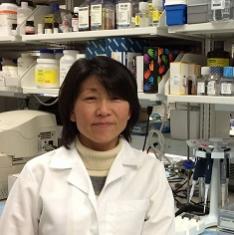
Noriko Sato, M.D., Ph.D.
- Center for Cancer Research
- National Cancer Institute
- Building 10, Room 1B55
- Bethesda, MD 20892-1002
- 240-858-3079
- 240-541-4527
- saton@mail.nih.gov
RESEARCH SUMMARY
Dr. Noriko Sato leads the Laboratory of Cellular Therapeutics in the Molecular Imaging Branch at the National Cancer Institute. Dr. Sato received her M.D. and Ph.D. from Kyoto University, Japan. Her research interests are on 1) development and usage of imaging technologies to investigate behavior of cells in vivo, 2) understanding immune cell activation mechanisms, by combining imaging and non-imaging techniques, and 3) modification of tumor microenvironment to improve cancer therapies. She is currently working to bring a new ex vivo cell labeling method to the clinic for real time monitoring of cell-based therapies by PET imaging.
Areas of Expertise
Research
The Laboratory of Cellular Therapeutics actively performs basic research in the Molecular Imaging Branch. Major focuses of research include:
1) Develop and use imaging technologies to investigate behavior of cells in vivo. We have pioneered a PET-based cell tracking method using a newly developed ex vivo cell labeling agent Zr-89 oxine. This technology enables highly sensitive, quantitative method of visualizing cell migration in vivo in real time. We examine cell trafficking in various condition or in response to various in vivo stimuli in mouse and non-human primate models.
2) Investigate immune cell activation/supression mechanisms, by combining imaging and non-imaging techniques. T cells are not always fully activated in vivo upon encountering with nominal antigen. Our projects aim to understand how T cells are activated or suppressed in vivo, especially in tumor microenvironment.
3) Modification of tumor microenvironment to improve cancer therapies. With a focus on activating anti-tumor immunity, we investigate methods to modify tumor microenvironment that leads to therapeutic improvement.
Publications
(89)Zr-Oxine Complex PET Cell Imaging in Monitoring Cell-based Therapies
Spatially selective depletion of tumor-associated regulatory T cells with near-infrared photoimmunotherapy.
CD4 effector T cell differentiation is controlled by IL-15 that is expressed and presented in trans.
Development of an IL-15-autocrine CD8 T-cell leukemia in IL-15-transgenic mice requires the cis expression of IL-15Ralpha
Bone marrow cell trafficking analyzed by 89Zr-oxine positron emission tomography in a murine transplantation model.
Biography

Noriko Sato, M.D., Ph.D.
Dr. Noriko Sato leads the Laboratory of Cellular Therapeutics in the Molecular Imaging Branch at the National Cancer Institute. Dr. Sato received her M.D. and Ph.D. from Kyoto University, Japan. Her research interest is on the 1) development and use of imaging technologies to better understand immune cell activation, 2) modification of tumor microenvironment, and 3) exploring methods to improve cancer therapies. She is currently working to bring a new ex vivo cell labeling method to the clinic for real time monitoring of cell-based therapies by PET imaging.

